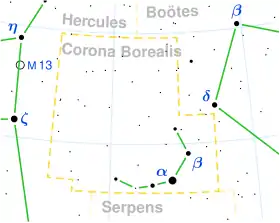Epsilon Coronae Borealis
Epsilon Coronae Borealis, Latinized from ε Coronae Borealis, is a multiple star system in the constellation Corona Borealis located around 230 light-years from the Solar System. It shines with a combined apparent magnitude of 4.13,[7] meaning it is visible to the unaided eye in all night skies except those brightly lit in inner city locations.[8] It is an orange giant around 1.7 times as massive as the Sun of spectral type K2III,[9] which has exhausted its core fuel supply of hydrogen and swollen to 21 times the Sun's diameter and 151 times its luminosity.[10] That is, Epsilon Coronae Borealis's diameter is about one-quarter of Mercury's orbit.[11] Its surface temperature has been calculated to be 4365 ± 9 K,[10] or 4406 ± 15 K.[9] It is thought to be around 1.74 billion years old.[9]
 | |
| Observation data Epoch J2000 Equinox J2000 | |
|---|---|
| Constellation | Corona Borealis |
| Right ascension | 15h 57m 35.25147s[1] |
| Declination | +26° 52′ 40.3635″[1] |
| Apparent magnitude (V) | 4.13[2] |
| Characteristics | |
| Spectral type | K2 III[2] |
| U−B color index | +1.28[3] |
| B−V color index | +1.235[3] |
| Astrometry | |
| Radial velocity (Rv) | –32.42[2] km/s |
| Proper motion (μ) | RA: –77.07[1] mas/yr Dec.: –60.61[1] mas/yr |
| Parallax (π) | 14.73 ± 0.21[1] mas |
| Distance | 221 ± 3 ly (67.9 ± 1.0 pc) |
| Absolute magnitude (MV) | −0.02[4] |
| Details | |
| Mass | 1.44±0.18[5] M☉ |
| Radius | 21[6] R☉ |
| Luminosity (bolometric) | 151[2] L☉ |
| Surface gravity (log g) | 1.94±0.15[5] cgs |
| Temperature | 4,365±28[2] K |
| Metallicity [Fe/H] | −0.22±0.03[5] dex |
| Rotational velocity (v sin i) | 2.4[6] km/s |
| Age | 4.13[2] Gyr |
| Other designations | |
| Database references | |
| SIMBAD | data |
Epsilon Coronae Borealis B is a companion star thought to be an orange dwarf of spectral types K3V to K9V that orbits at a distance of 135 astronomical units, completing one orbit every 900 years.[11]
A faint (magnitude 11.5) star, 1.5 arc minutes away, has been called Epsilon Coronae Borealis C although it is only close by line of sight and is unrelated to the system.[11][12]
The ε CrB star system's radial velocity was observed over seven years from January 2005 to January 2012, during which time a 'wobble' with a period of around 418 days was recorded. This has been calculated to be a planet around 6.7 times as massive as Jupiter orbiting at a distance of 1.3 astronomical units with an eccentricity of 0.11.[9]
Epsilon Coronae Borealis lies one degree north of (and is used as a guide for) the variable T Coronae Borealis.[11]
| Companion (in order from star) |
Mass | Semimajor axis (AU) |
Orbital period (days) |
Eccentricity | Inclination | Radius |
|---|---|---|---|---|---|---|
| b | ≥6.7 ± 0.3 MJ | 1.3 | 417.9 ± 0.5 | 0.11 ± 0.03 | — | — |
References
- van Leeuwen, F. (2007), "Validation of the new Hipparcos reduction", Astronomy and Astrophysics, 474 (2): 653–664, arXiv:0708.1752, Bibcode:2007A&A...474..653V, doi:10.1051/0004-6361:20078357.
- Luck, R. Earle (2015), "Abundances in the Local Region. I. G and K Giants", The Astronomical Journal, 150 (3): 88, arXiv:1507.01466, Bibcode:2015AJ....150...88L, doi:10.1088/0004-6256/150/3/88.
- Mermilliod, J.-C. (1986), "Compilation of Eggen's UBV data, transformed to UBV (unpublished)", Catalogue of Eggen's UBV Data. SIMBAD, Bibcode:1986EgUBV........0M.
- Anderson, E.; Francis, Ch. (2012), "XHIP: An extended hipparcos compilation", Astronomy Letters, 38 (5): 331, arXiv:1108.4971, Bibcode:2012AstL...38..331A, doi:10.1134/S1063773712050015.
- Mortier, A.; et al. (September 2013), "New and updated stellar parameters for 71 evolved planet hosts. On the metallicity-giant planet connection", Astronomy & Astrophysics, 557: 19, arXiv:1307.7870, Bibcode:2013A&A...557A..70M, doi:10.1051/0004-6361/201321641, A70.
- Massarotti, Alessandro; et al. (January 2008), "Rotational and radial velocities for a sample of 761 HIPPARCOS giants and the role of binarity", The Astronomical Journal, 135 (1): 209–231, Bibcode:2008AJ....135..209M, doi:10.1088/0004-6256/135/1/209.
- "eps CrB". SIMBAD. Centre de données astronomiques de Strasbourg. Retrieved 2017-03-17.
- Bortle, John E. (February 2001). "The Bortle Dark-Sky Scale". Sky & Telescope. Sky Publishing Corporation. Retrieved 2013-02-20.
- Lee, B.-C.; Han, I.; Park, M.-G.; Mkrtichian, D. E.; Kim, K.-M. (2012). "A planetary companion around the K giant ɛ Corona Borealis". Astronomy & Astrophysics. 546: 5. arXiv:1209.1187. Bibcode:2012A&A...546A...5L. doi:10.1051/0004-6361/201219347. A5.
- Massarotti, Alessandro; Latham, David W.; Stefanik, Robert P.; Fogel, Jeffrey (January 2008). "Rotational and Radial Velocities for a Sample of 761 HIPPARCOS Giants and the Role of Binarity". The Astronomical Journal. 135 (1): 209–31. Bibcode:2008AJ....135..209M. doi:10.1088/0004-6256/135/1/209.
- Kaler, James B. (19 August 2011). "Epsilon and T Coronae Borealis". Stars. University of Illinois. Retrieved 16 November 2014.
- SIMBAD, CCDM J15576+2652C -- Star in double system (accessed 16 November 2014)
- Jean Schneider (2003). "Planet eps CrB b". Extrasolar Planets Encyclopaedia. Retrieved 4 February 2017.